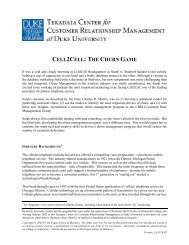Equilibrium Growth, Inflation, and Bond Yields - Duke University's ...
Equilibrium Growth, Inflation, and Bond Yields - Duke University's ...
Equilibrium Growth, Inflation, and Bond Yields - Duke University's ...
You also want an ePaper? Increase the reach of your titles
YUMPU automatically turns print PDFs into web optimized ePapers that Google loves.
where Pt is the nominal price for the final good, Xi,t is intermediate good input i ∈ [0, 1], <strong>and</strong> Pi,t is the<br />
nominal price for the intermediate good.<br />
The first-order condition with respect to Xi,t is<br />
which can be rewritten as<br />
Pt<br />
�� 1<br />
0<br />
X ν−1<br />
ν<br />
i,t di<br />
� ν<br />
ν−1 −1<br />
Pi,t = Pt<br />
� Xi,t<br />
Yt<br />
− 1<br />
ν<br />
Xi,t − Pi,t = 0<br />
� − 1<br />
ν<br />
Using the expression above, for any two intermediate goods i, j ∈ [0, 1],<br />
Xi,t = Xj,t<br />
� Pi,t<br />
Since markets are perfectly competitive in the final goods sector, the zero profit condition must hold:<br />
Substituting (11) into (12) gives<br />
PtYt =<br />
� 1<br />
0<br />
Xi,t = PtYt<br />
Substitute (10) into (13) to obtain the price index<br />
Pt =<br />
�� 1<br />
0<br />
Pj,t<br />
� −ν<br />
(10)<br />
(11)<br />
Pi,tXi,t di (12)<br />
P −ν<br />
i,t<br />
� 1<br />
0 P1−ν j,t dj<br />
P 1−ν<br />
j,t dj<br />
� 1<br />
1−ν<br />
Given the expression for the price index, (13) can be rewritten as<br />
Xi,t = Yt<br />
� Pi,t<br />
Pt<br />
Since each intermediate goods firm is atomistic, their actions will not effect Yt nor Pt. Thus, each of these<br />
� −ν<br />
firms will face an isoelastic dem<strong>and</strong> curve with price elasticity ν.<br />
32<br />
(13)
















